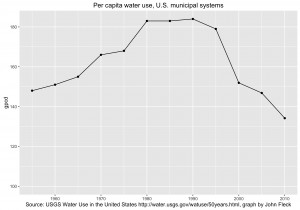
U.S. per capita water use has been declining for two decades
Every toilet currently in stock at my local Home Depot has the EPA WaterSense label, even the cheapest ones, meaning they uses 1.28 gallons per flush or less. This is a big part of why we see water use – on a per capita basis, but also in some cases on an absolute basis – going down in the United States.
The current U.S. legal standard, set in the Energy Policy Act of 1992 (signed during the first Bush administration), is 1.6 gallons per flush. Prior to that, most toilets used more than 3 gallons, some of them 5. The EPA program simply offers a catchy label and bragging rights for going lower, but if my Home Depot is any indication it appears to have caught on. The ’92 federal law also set standards for urinals, faucets, and showers. The result is that every new plumbing fixture in an old building uses less water than the one it replaces, and every new building starts off with a baseline water use far lower than the old stuff.
You can see the curve start to bend down in the 1990s, which I think must be related to the new plumbing standards.
states’ tougher standards

total U.S. municipal water use is now declining
A number of states, including California and that drought-plagued bastion of liberty Texas, have made the lower EPA number a state mandate, along with tougher standards for other fixtures.
You can see how, over time, that would push down per capita use. But population’s still growing, right? The USGS’s 2010 Water Use in the United States report, however, documented an important milestone. For the first time in the data (which goes back to 1955), total municipal water use actually went down, even as population rose by more than 10 million since the 2005 report. Conservation reductions are outpacing population growth in the United States.
Work begins this year on the next iteration of the USGS series. I’m looking forward to seeing whether 2015 continues the trend.
